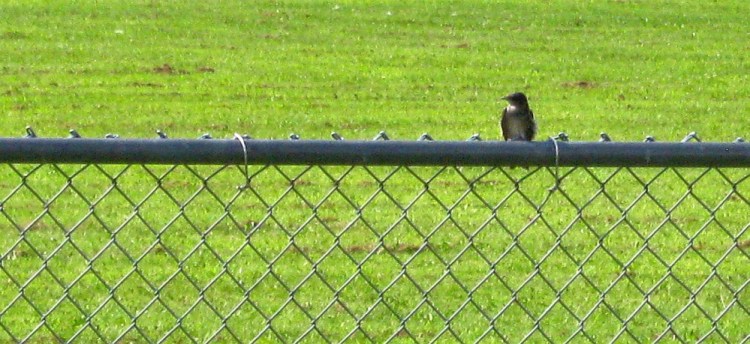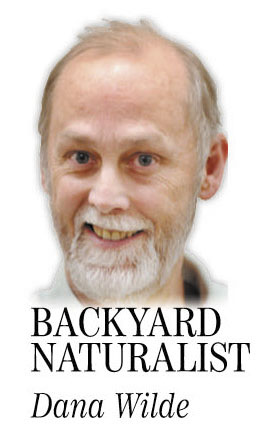In early August, as always, the purple martins packed up from their annual gig at the Unity park and headed south.
A day or two after this event, when I stopped in to make the walking-path circuit, a solitary martin was sitting on the chain link fence around the baseball field, 50 or 60 feet west of the bird condo. The martins are normally chattery-loud, but this one, with a kind of scruffy, old-man look, struck only a single little chirp in irregular time. Fat seconds, a minute, two or three would go by silent, then he’d chirp again in that tenor-sounding purple martin voice.
What was he doing by himself, quiet and mostly unmoving except for the occasional hunch of a shoulder or twitch of the head?
I listened, motionless and still myself, for 10 minutes or so, then strolled the round of the park. When I got back he was still by himself on the fence singing one plaintive note every little timeless while. My mind wandered onto the notion that he was posted there to round up the stragglers who missed the general southward vamoose a day or two before. This idea modulated the whole afternoon, the hazy clouds, the woods, the declining summer lake light deep into a minor key. The martin alone on the fence chipped an inexpressible autumn melancholy right into the spot of time itself.
In about half an hour, two other martins materialized in the air over the baseball field. In the outfield, crows meanwhile were parading around and scolding each other. The two martins darted in and out of the birdhouse, chattering cheerily, tardy though they were in my scheme. After a few minutes of this aerial nonsense, the solitary martin stretched out his wings and took off, made a few loops around the grounds, a few airborne chips of sound, and then dematerialized in the haze.
It just seemed unutterably sad. The last purple martin posted like an avian elder to round up the last of the flock. The first sign of fall. The loneliness, loss or natural sorrow that is the inner shape of the sadness — so Poe said — that is connected with certain revelations of beauty. Or whatever you call that piercing feeling you get when September strikes.
Unsure of anything but the feeling itself, I asked one of my birding advisers if this geriatric-seeming bird was indeed the end-of-summer counterpart to the scouts who arrive early in spring to check out last year’s digs before the rest of the flock arrives.
First of all, she said, the bird was not old, but probably in some stage of molt, possibly even young. And second, birds don’t help each other migrate. Why one sat by itself on the fence for an hour, we’ll never be able to say.
The next day, as it happened, the birdhouse was a clattering chaos of martins again. They had not left after all. Unless this was a whole different flock passing through. No way to know that, either.
So in ornithological fact, my whole hour brooding over the solitary martin was a complete fantasy. The lonely late-summer sense of an approaching ending toward inevitable fall and winter and all its natural metaphors was, for all intents and purposes, a self-made mirage.
This put me in mind of another recurrently spoken-of incident from decades ago. A friend and I were visiting the home in Waldoboro of an eminent poet, when we stepped outside to look at a particularly rosy winter sunset. Studying one unusual-looking streak in the sky, I said, “I think that might be the comet.” This got them excited and we talked about comets and other seemingly related aesthetic experiences long into the evening.
Uneasy about the facts of reality, as usual, I later went to the library (no Googling in those days) to find out exactly where the comet was, and realized I was wrong. It must have been a jet contrail. So I wrote to the wise old poet to set him straight about what we actually saw.
He insisted it was the comet. And he would not let it go. When I visited him in Buffalo a year or two later, and in correspondence afterward, he’d bring it up and flatly declare that our original reading of the sky was correct: It was in fact the comet, he said again and again. Even though, I kept thinking, it was not the comet.
I don’t want to get on the wrong side of the scientists.
However, there is a contentious issue in philosophy sometimes called The Mary Problem. Mary is a hypothetical neuroscientist who studies the perception and processing of light in the brain. She knows all there is to know about how photons enter the eye, strike the retina, process through rod and cone cells down through optic nerves and deep inside where your biochemicals register shapes, colors and motion. She knows all there is to know about the physical properties and behaviors of light.
One minor detail: Mary has lived her whole life only in a room with no color, only black, white and gray light. So when she steps out of the room and perceives blue for the first time, suddenly she knows something about light that she didn’t know when she knew everything about it. There is more to reality, this argument concludes, than the physical facts. The framer of The Mary Problem also adds the nonhypothetical fact that while we know there is an ultraviolet color, we don’t know what it looks like because we can’t see it (while some insects, spiders and birds can).
What does all this have to do with the solitary martin? Nothing you can say solves it. Despite my completely mistaken ornithological speculations about his presence on the fence at the Unity park, the autumn loneliness of that moment is with me like a gorgeous melody long after, as real as a cascading blue autumn sky.
Dana Wilde lives in Troy. His writings on Maine’s natural world are collected in “The Other End of the Driveway,” available from online booksellers or by contacting the author at naturalist@dwildepress.net. Backyard Naturalist appears the second and fourth Thursdays each month.
Send questions/comments to the editors.




Success. Please wait for the page to reload. If the page does not reload within 5 seconds, please refresh the page.
Enter your email and password to access comments.
Hi, to comment on stories you must . This profile is in addition to your subscription and website login.
Already have a commenting profile? .
Invalid username/password.
Please check your email to confirm and complete your registration.
Only subscribers are eligible to post comments. Please subscribe or login first for digital access. Here’s why.
Use the form below to reset your password. When you've submitted your account email, we will send an email with a reset code.